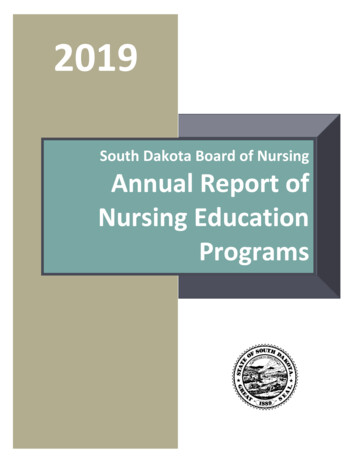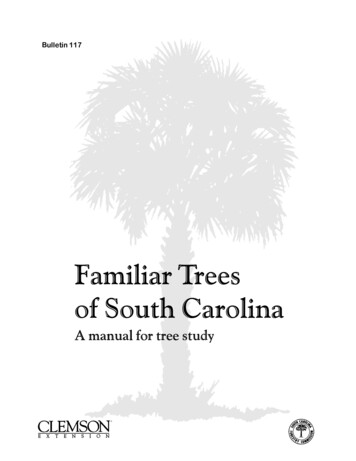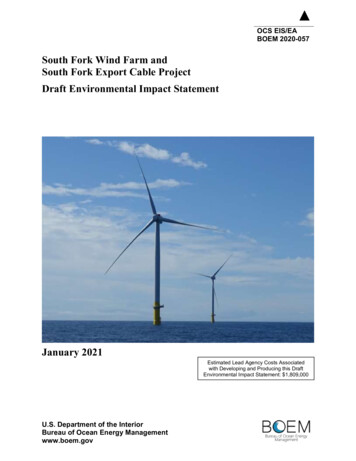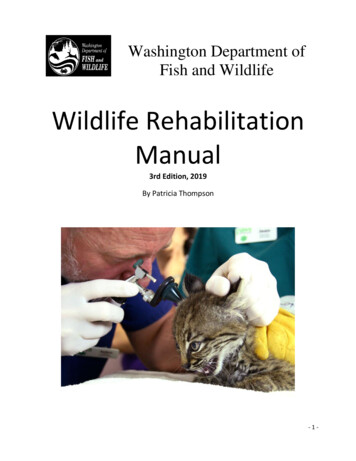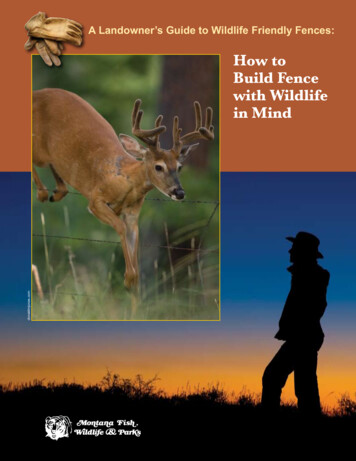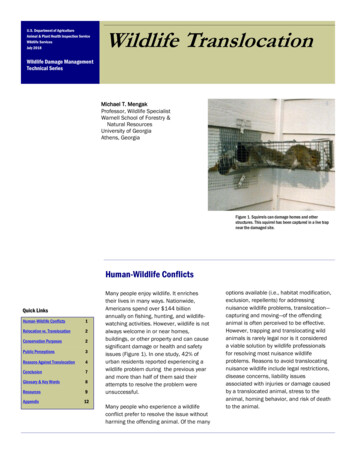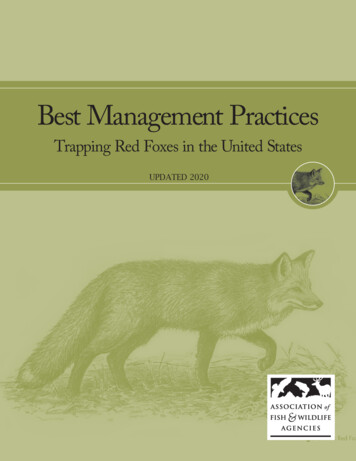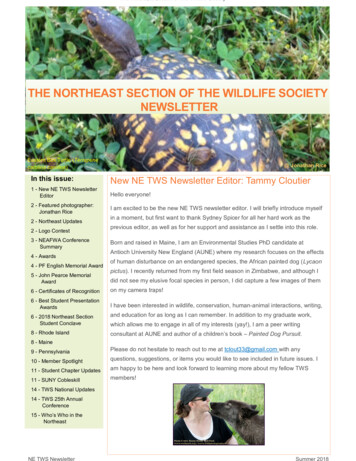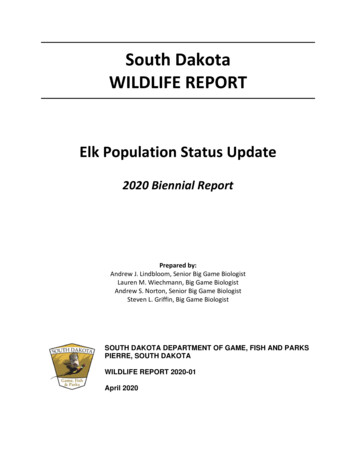
Transcription
South DakotaWILDLIFE REPORTElk Population Status Update2020 Biennial ReportPrepared by:Andrew J. Lindbloom, Senior Big Game BiologistLauren M. Wiechmann, Big Game BiologistAndrew S. Norton, Senior Big Game BiologistSteven L. Griffin, Big Game BiologistSOUTH DAKOTA DEPARTMENT OF GAME, FISH AND PARKSPIERRE, SOUTH DAKOTAWILDLIFE REPORT 2020-01April 2020
“Authorized Use – These data are the property of the South Dakota Department of Game, Fish,and Parks. No part of this report may be used (including but not limited to use in publicationsand/or presentations), redistributed, copied or reproduced in any form, without the priorwritten consent of the South Dakota Department of Game, Fish, and Parks. Any use,redistribution, copying or reproduction of the data appearing in this report without the priorwritten consent of the South Dakota Department of Game, Fish, and Parks is expresslyprohibited.”i
TABLE OF CONTENTSTable of Contents .iiLIST OF TABLES .iiiLIST OF FIGURES .iiiINTRODUCTION . 1Population surveys and assessments . 1Population Assessments . 1Hunting Season Evaluations . 2Harvest Surveys . 2Harvest Age Structure. 7CWD Testing of Harvested Elk . 9Herd Composition Surveys . 11Survival Monitoring . 11Aerial Sightability Surveys . 14Population Modeling . 16Summary . 17LITERATURE CITED . 18ii
LIST OF TABLESTable 1.Table 2.Table 3.Table 4.Black Hills Firearm elk harvest, 2010-2019 (Huxoll 2019). . 5Archery elk harvest in the Black Hills, 2010-2019 (Huxoll 2019). . 6Elk harvest in Custer State Park, 2015-2019 (Huxoll 2019). . 8Prairie Firearm Elk harvest, 2010-2019 (Huxoll 2019). . 8LIST OF FIGURESFigure 1. Population objective directions for elk units in South Dakota, 2020. . 3Figure 2. Harvest of elk from all hunting seasons in the Black Hills, 1990-2019. . 4Figure 3. Total Black Hills elk license sales (firearm and archery) for antlerless and “any elk”license types, 2000-2019. . 4Figure 4. Black Hills firearm elk harvest for each elk hunting unit, 2015-2019. . 5Figure 5. Black Hills firearm “any elk” license harvest success for each elk hunting unit, 20152019. . 6Figure 6. Black Hills Archery elk harvest, 2015-2019. . 7Figure 7. Age distribution of hunter harvested bull elk in the firearm and archery seasonswithin the Black Hills (excluding CSP), 1991-2019. The 30% minimum threshold for bull harvestin the 4 age category is identified by the horizontal line. . 9Figure 8. Map of CWD positive elk collected from hunter harvest or other collection methods,2019-2020. . 10Figure 9. Fall sex ratios of elk (with 95% error bars) in the Black Hills and CSP, 2013-2019. . 12Figure 10. Fall age ratios of elk (with 95% error bars) in the Black Hills and CSP, 2013-2019. . 12Figure 11. Photo of elk herd during aerial sightability survey, 2016. . 14Figure 12. Aerial Sightability survey heat map of elk counts in 2020. . 15iii
INTRODUCTIONNative to South Dakota, elk (Cervus elaphus) are the largest hunted member of the deer family(Cervidae) residing in the state. Extirpated in the late 1800s, the re-establishment of elk inSouth Dakota is a wildlife management success story. Today several thousand elk roam free,primarily in the Black Hills forested region along with several smaller herds occupying prairieand/or agriculture landscapes. Public demand for elk hunting opportunities is strong, withhunters submitting 30,782 applications for 1,336 available elk licenses in 2019.Elk hunting seasons in South Dakota provide an important recreational opportunity for residentsportsmen and women, and also provide a means to manage elk populations. The currentover-riding goal for elk management is to “manage elk populations and habitats consistent withecological, social, aesthetic, and economic values of South Dakota citizens while addressing theconcerns and issues of both residents and visitors of South Dakota” (South Dakota Game, Fishand Parks 2015). More specific information on elk management objectives, strategies, andresearch in South Dakota can be found in the South Dakota Elk Management Plan Final.pdf.The following report provides a statewide overview of elk surveys and assessments conductedby the South Dakota Department of Game, Fish, and Parks (SDGFP) and an update on thepopulation status of elk in the Black Hills.POPULATION SURVEYS AND ASSESSMENTSPopulation AssessmentsThe majority of elk herds in South Dakota occur within the Black Hills. The current Black Hillspopulation objective (excluding Custer State Park and Wind Cave National Park) is 7,000wintering elk, but may range from 6,000 to 8,000 depending on habitat conditions (SDGFP2015). The current population objective for Custer State Park (CSP) is 800 wintering elk, with arange from 700-900 depending on habitat conditions. These goals were developed afterthorough analyses of elk population data, available habitat resources on public land, privateland depredation issues, and substantial input from a wide variety of publics with an interest inelk management in South Dakota.The primary surveys and data assessments used to evaluate elk population abundance andtrends in the Black Hills include the following: 1) hunting season evaluations (harvest surveys,harvest age structure, disease testing), 2) herd composition surveys, 3) survival monitoring, 4)aerial sightability surveys, and 5) population modeling.Survey data are lacking for most prairie units and elk densities are primarily managed to abatesubstantial agricultural damages on private property while at the same time to providerecreational hunting opportunity.1
Hunting Season EvaluationsElk hunting licenses in South Dakota are limited in all management units and issued through alottery draw system. For all elk hunting units and seasons (excluding CSP), up to 50% of elklicenses allocated in each management unit are available to those who qualify forlandowner/operator preference. Based on current South Dakota Administrative Rules (ARSD),the 2018 and 2019 hunting seasons in the Black Hills began with the archery season openSeptember 1-30 (ARSD 41:06:43). The firearm season for “any elk” licenses ran Oct 1-31 (ARSD41:06:26:01). Antlerless firearm hunting seasons were October 16-31, Dec 1-15, and Dec 16-31.Contingency licenses are made available for Black Hills units after the harvest seasons havebeen set if weather and range conditions necessitate a reduction to the grazing pressure on thelandscape. No contingency licenses were issued in 2018 and 2019. Hunting seasons in CSP(ARSD 41:06:27, 41:06:28, 41:06:47, 41:06:48) are similar but may vary depending on Parkobjectives. Prairie elk hunting seasons (ARSD 41:06:59) vary and are a collaborative effortbetween SDGFP and private landowners to manage elk populations in agricultural settings.There are currently eight elk management units in the Black Hills (Units H1, H2, H3, H4, H5, H7,H9, and CSP; Figure 1). Several of these units are further subdivided by area and season datefor purposes of antlerless harvest management. In addition, there are currently seven prairieelk management units with hunting seasons (Units 09, 11, 15, 27, 35a, 35b, WRA; Figure 1).Management objective directions (increase, maintain, or decrease) are set every two yearswhen season recommendations are brought forward to the SDGFP commission (Figure 1). Elkmanagement objectives for each management unit are based on elk population assessments,habitat conditions, and social considerations. Management objectives on the prairie can varysubstantially between areas.Harvest SurveysAll elk hunters, regardless of hunting success or participation, are currently surveyed to assessoverall harvest and hunter success. In addition, all successful hunters are required to check-inany harvested elk to a SDGFP representative within 24 hours (ARSD 41:06:04:19). Huntersurvey cards are emailed and/or mailed to all elk license holders to obtain information on thenumber of hunting recreation days, gender and age (adult/calf) of elk harvested, type of landhunted (public vs. private), number of elk shot but not recovered, and mean satisfaction of thehunt. All license holders who list an email in their licensing profile receive an email at the endof the season followed by two reminder emails over a 2-week period. All license holders thatdo not list an email, and those that do not respond to the email survey, are sent paper surveysfollowed by two or three subsequent mailings at 12-14 day intervals in order to maximizeresponse rate and precision by limiting non-response bias.2
Figure 1. Population objective directions for elk units in South Dakota, 2020.Returned hunter surveys are entered and summarized, and harvest statistics are generated foreach unit. Proportional statistics from the sample are then accepted as representative of theunit population of hunters and applied to the total number of hunters in that unit. Hunterswho do not respond to the survey are included in the hunter population when estimatingharvest statistics. The minimum acceptable response rate has been established at 85%.Confidence intervals are calculated to monitor precision. Harvest information specific to eachseason, unit, and license type are published annually (Huxoll 2019).Over the past 10 years, peak elk harvest occurred in 2016 and 2017 at 1,087 and 1,049,respectively (Figure 2). Significant increases in antlerless license types and subsequent cowharvest were obtained during these years to meet population management objectives (Figures2 and 3). The availability of “any elk” license types has remained relatively stable since 2010(Figure 3). From 2004 to 2019, the average number of “any elk” and antlerless elk licenses soldeach year has been 653 and 932, respectively.3
16001400Elk ojected HarvestMale harvestFemale HarvestFigure 2. Harvest of elk from all hunting seasons in the Black Hills, 1990-2019.Black Hills Elk License Sales2500200015001000500"Any Elk" 092008200720062005200420032002200120000Antlerless Elk LicensesFigure 3. Total Black Hills elk license sales (firearm and archery) for antlerless and “any elk”license types, 2000-2019.Public demand for firearm elk hunting licenses in the Black Hills is high, with nearly 12,400hunters applying for approximately 1,100 licenses in 2019 (Table 1). Hunters spend an averageof five days pursuing elk in the firearm season. Harvest rates vary across each hunting unit, butUnit 2 has higher elk densities and elk harvest rates than all other hunting units combined(Figure 4).4
Firearm hunter success rates in the Black Hills have been 53-73% over that past 10 years. TheElk Management Plan Objective (SDGFP 2015; Objective 3, Strategy B) is to manage for aminimum of 60% hunter success for hunters with an “any elk” Black Hills and CSP firearmlicense type. Firearm hunters with “any elk” licenses experienced success rates of 87% in 2019,thus meeting and exceeding the minimum thresholds established in the Elk Management Plan.Harvest success can vary substantially between years and units, but firearm hunter success inthe Black Hills has been increasing the past five y
hunters submitting 30,782 applications for 1,336 available elk licenses in 2019. Elk hunting seasons in South Dakota provide an important recreational opportunity for resident sportsmen and women, and also provide a means to manage elk populations. The current over-riding goal for elk management is to “manage elk populations and habitats consistent with ecological, social, aesthetic, and .
